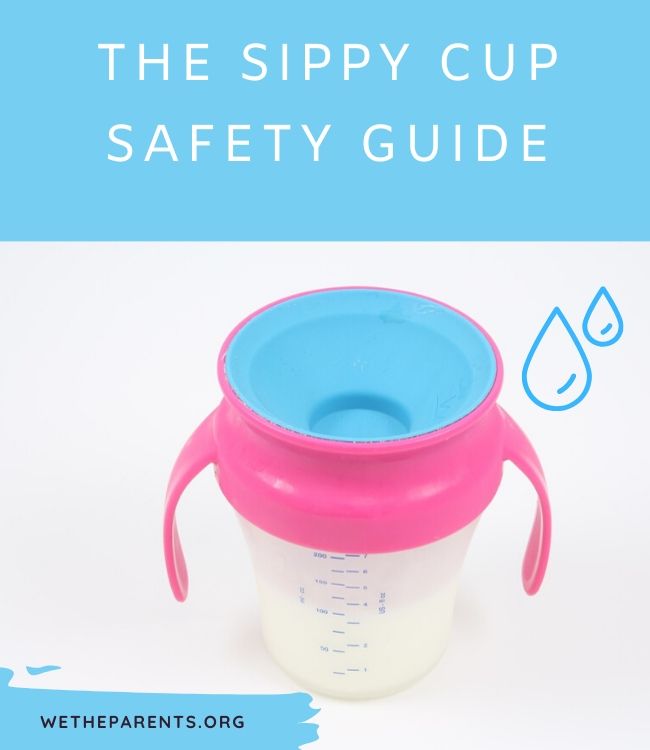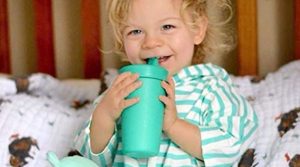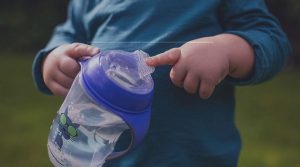As parents, one of our first priorities in caring for our children is to keep them safe from harm. A large part of achieving this goal is knowing how to use their gear correctly; car seats, harnesses, even seemingly innocuous items like sippy cups can pose hazards if you don’t know the rules of proper use. Believe it or not, even the incorrect use of sippy cups can lead to potential hazards, and knowing how to avoid them can reduce this considerably.
In this article:
So, does my child really need a sippy cup?
As one of the main reasons for using a sippy cup is to train your child to use a regular cup rather than a bottle, you may wonder if that’s actually necessary. While the answer is, technically, ‘no’, sippy cups help your child make the switch from bottles to open cups while causing far less mess.
Yes, you could try introducing your little one to a cup without a lid, but cleaning up the repeated mess during this learning period won’t be another chore you’ve been looking forward to. A sippy cup is a more than useful transitional item as long as it’s sturdy, leakproof, and used correctly.
Apart from preventing a mess, how are sippy cups helpful?
- They make travel easy. Just like you, your little one needs to drink while on the go. Though accustomed to a bottle, once they’ve weaned, that’s no longer an acceptable option. A sippy cup enables them to drink while in the car, at the park, or anywhere in general. From the parental perspective, this will remove the problem of spillage on clothes or car upholstery, etc.
- Hydration is essential. We’re well aware how important hydration is for our wellbeing, and especially for your little one. Regular access to fluids will provide this.1Popkin, B. M., D’Anci, K. E., & Rosenberg, I. H. (2010).Water, hydration, and health. Nutrition reviews, 68(8), 439-458.
ncbi.nlm.nih.gov - They help kids master the motions. Holding and drinking from a real cup requires the use of different motor skills than toddlers use during breastfeeding or bottle feeding. Grasping a cup, lifting it to their mouth, and taking a sip help them learn the motions needed to drink from a real cup.
- Issues associated with long term bottle use are avoided. Bottles are easy and familiar, but not weaning your baby off of their bottle by the appropriate age (one year is recommended can cause some long term issues including tooth decay. Weaning to a sippy cup that’s used in a healthy, proper manner can mitigate these issues.2Rizal, M. F., Sutadi, H., Bachtiar, B. M., & Bachtiar, E. W. (2010). The frequency of bottle feeding as the main factor of baby bottle tooth decay syndrome.Dental Journal (Majalah Kedokteran Gigi), 43(1), 44-48.researchgate.net
- Issues associated with long term bottle use are avoided. Bottles are easy and familiar, but not weaning your baby off of their bottle by the appropriate age (one year is recommended, but 18 months is the absolute max) can cause some long term issues including tooth decay, failure to develop a mature swallow reflex, ear infections, and speech delays and impediments. Weaning to a sippy cup that’s used in a healthy, proper manner can mitigate these issues.
In what ways can sippy cups be dangerous for my child?
Sippy cups are fairly innocuous pieces of baby gear that shouldn’t pose any harm, unless used improperly, especially over an extended period of time. Some issues to consider are as follows:
- Hard spouts shouldn’t be used consistently. Sippy cups with hard spouts are often what comes to mind when discussing these items, but they’re not necessarily the best choice for your child’s future orthodontic health. Improper tooth development, tongue placement, and swallow reflex can all be caused by frequent use of hard spouted sippy cups; this can then impact sleeping habits, facial appearance, and possibly create a need for future, otherwise avoidable, orthodontia.
- Orthodontic and speech issues. Overuse of sippy cups can lead to orthodontic problems, though, while the internet commonly discusses such issues, these can often be exaggerated. A more pertinent concern is that sippy cups can sometimes encourage immature sucking patterns, a possible obstacle to speech development.
- Small crevices are a breeding ground for nasties. Little crevices, like screw-on cap threads, narrow spouts, and tiny straws all create perfect environments for mold and mildew; both of which can be hard to clean and dry.3Tinanoff, N., & Palmer, C. A. (2000). Dietary determinants of dental caries and dietary recommendations for preschool children.Journal of public health dentistry, 60(3), 197-206.health.maryland.gov
- They play a role in a lot of household accidents. When kids are permitted to run around drinking from their cup, a fall that may have otherwise been no big deal can turn into an unexpected trip to urgent care; cuts, bruises, and even broken teeth have happened because of cup use not monitored.
- Tooth decay can be an issue. Unfettered access to sugary drinks like soda, juice and milk over extended periods of time rather than in short intervals at mealtime is the primary issue leading to tooth decay. In between meals water is the best liquid.4Doğramacı, E. J., & Rossi-Fedele, G. (2016). Establishing the association between nonnutritive sucking behavior and malocclusions: a systematic review and meta-analysis. The Journal of the American Dental Association, 147(12), 926-934.
PubMed.org - It can lead to the early establishment of problematic eating behaviors. If little ones are given constant access to sugary drinks in their sippy cup, especially to calm them when they’re agitated, they may begin to look to the drink as a source of pleasure and pacification. This can train them to look toward food and drink as a source of comfort, a behavior pattern that’s linked to weight gain.5Michels, N., Sioen, I., Braet, C., Eiben, G., Hebestreit, A., Huybrechts, I., … & De Henauw, S. (2012). Stress, emotional eating behaviour and dietary patterns in children.Appetite, 59(3), 762-769.
biblio.ugent.be
What sippy cup types are available, and what’s good and bad about each?
Hard-spouted
The pros: These traditional cups are okay for occasional use, and tend to be less expensive than their fancier counterparts. They excel at regulating the flow of liquid and prevent leaks during travel.
The cons: Not recommended for constant use, as they can interfere with normal speech development in extreme cases.
Soft-spouted
The pros: Unlike hard-spouted cups, they use soft plastic or silicone to create a spout that flexes to accommodate a baby’s tongue and teeth.
The cons: Though healthier than hard-spouted sippy cups, silicone and soft plastic tend to degrade faster, and cleaning them thoroughly can be difficult, especially if there’s a secondary valve piece. Children with teeth can also bite through the silicone spout or straw, causing it to become a choking hazard.
Spoutless
The pros: They do the best job of simulating the sensation of drinking from a regular glass.
The cons: Getting accustomed to these cups can feel awkward for kids just transitioning from a bottle.
Straw cups
The pros: They’re ideal for developing healthy tongue positioning, mature swallow reflex, avoiding tooth decay, and otherwise promoting good orthodontic health.
The cons: If not well-made, they can be leakier than their spouted counterparts, and they don’t really demonstrate what drinking out of a real cup without a straw feels like.
The five sippy cup safety commandments
Sippy cups can be a perfectly safe transitional tool if used correctly, which, honestly, isn’t too tough. The key is to know the best practices, thus, we’ve made it simple with the Five Sippy Cup Safety Commandments; they’re as easy to follow as they are important, so check them out to be sure you’re using and maintaining their sippy cups correctly.
- Stop, sit, and drink. Although your little one might want to tote their sippy cup with them while running around, this can lead to an accident if a fall happens. Establish drinking habits like sitting down quietly to drink from their cup, putting it down on the table, and returning to their activity of choice thus reducing the potential for unnecessary mishaps.
- Always be cleaning. A rinse really isn’t sufficient to thoroughly clean your kiddo’s sippy cup, even if they’ve just been drinking water. Use hot water, soap, and a cleaning brush with small bristles that reaches into every nook and cranny of their cups and lids, especially those hard-to-reach areas like lid threads, spouts, valves, and crevices where bacteria and debris can linger. A small bottle brush is a great cleaning tool for little straws, which can get especially gross with repeated use.
- Time limits are essential. Occasional treats like chocolate milk and sugary juices are a natural and healthy part of childhood, but shouldn’t be on constant access via your little one’s sippy cup for several reasons. First, sugary liquid passing regularly over their front teeth, rather than for a few minutes at mealtime, can contribute to tooth decay. Second, sugary drinks given to calm or reassure kids can create a link in their mind between “unhealthy” food/drink and reassurance, which can possibly lead to future weight issues. Stick to offering such treats either during or after mealtimes only, so they don’t have that emotional association and aren’t constantly accessible.
- Soft, straw, or spoutless. While it’s okay to use hard-spouted sippy cups occasionally, there are some serious issues associated with their consistent, long-term use. It’s best to stick to soft-spouted, spoutless, or straw cups for your little one, all of which reduce the risks sometimes posed by hard spouts.
- Practice regular cups too. Once they’ve become accustomed to their sippy cup, gradually begin training them to drink from a regular cup during meal time, too. Just as you phased in sippy cups prior to weaning them from the bottle, this will encourage them towards a new way of drinking. Small, light-weight plastic cups of water at dinnertime are best, accidental spills being easy to clean.
Our takeaways
The key to using sippy cups safely lies in correct, balanced use. It helps to have a small range of cups on hand, primarily focusing on soft spouts and straws as they initially transition towards using a cup. You can then move on to spoutless as they become more familiar with drinking from a cup. Establishing good habits such as sitting down while drinking, and offering water most of the time, can help mitigate mishaps, tooth decay, and the formation of unwanted habits. Finally, thoroughly cleansing cups and storing them in a clean, dry place will increase their longevity by preventing the onset of mold and mildew.




